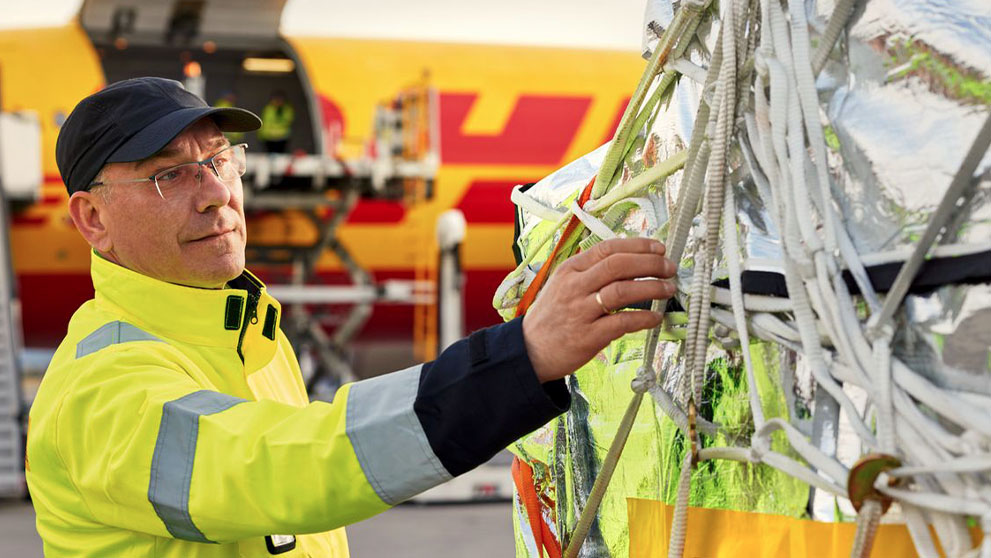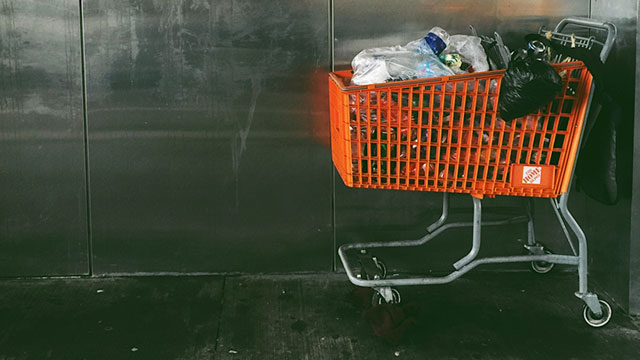Do you know your Customs Clearance from your Customs Declaration? Or the difference between First-mile Delivery and On-demand Delivery?
Within logistics, there can be a lot of terminology to understand. So, as experts in international shipping, we’ve broken down the jargon into an easy-to-understand glossary to help your business navigate it all with ease.

A - C
This is a Latin term meaning “according to the value”. All duties and taxes are calculated on the basis of value, so you may see this quite often when shipping internationally.
When a business exports goods at a significantly lower price than it usually charges in its home market, the destination country’s government may charge anti-dumping duty. This is an import duty designed to protect the competing domestic industry.
Sometimes referred to as the “Passport for goods”, the ATA Carnet is an international customs and temporary export-import document recognized in over 80 countries. It permits the duty-free and tax-free temporary import of goods that will be re-exported within 12 months. As an example, an exhibitor travelling round the world to multiple destinations can use an ATA Carnet to quickly clear their goods through customs, and without paying import duties or taxes.
This certification – introduced by the World Customs Organization after 9/11 – signifies a business’s cross-border flow of goods is safe and secure. AEO-certified businesses have many advantages, such as fewer delays at customs controls and lower inspection costs.
The electronic AES system is used by exporters based in the US to declare their international exports to the Census Bureau (which uses the data to compile statistics.) Businesses exporting goods valued at over US$2,500, or goods that need an export license, are required to register through AES.
The Automated Tariff and Local Customs Clearance System is the software used by the German customs administration to automatically register, clear and monitor cross-border trade. Documents – such as import duty declarations – can be entered electronically and then sent to the customs authorities.
The “Admission Temporaire Roulette” certificate is used to grant preferential rates of duty (usually zero) for goods traded between the EU and Turkey. It allows industrial goods (which in this instance includes consumer items) to be imported/exported between the markets free from normal non-EU customs tariffs.
An Air Waybill acts as an international shipment’s ‘passport’. It contains important information like the sender’s and recipient’s names and addresses, the package’s contents, and who is liable to pay the duties and taxes. Customs authorities use this to process and track it. This step-by-step guide will talk you through the integral elements of an Air Waybill so that your shipment is not delayed at customs.
This refers to obstacles faced by new businesses entering a given market. Examples include high startup costs, the need for legal licenses, competition from well-established businesses, and target customers’ long-standing loyalty to said businesses. But don’t be deterred! Check out 10 things would-be entrepreneurs should know before starting a business.
This is a legal document issued by a carrier (for example, DHL) to a shipper and represents the agreed terms and conditions for the transportation – such as destination and handling instructions. It also acts as proof of shipment – it contains the signatures of the shipper and a representative of the carrier, followed by a signature from the recipient upon delivery. The document should accompany the shipment to help prevent asset theft.
This is the address a person or company – such as an e-commerce customer – receives a bill to. It is linked to the buyer’s bank or payment platform and so is used to verify their identity. It should not be confused with the shipping address (where the buyer wants the goods to be delivered.)
These are goods stored in a secure warehouse. While they remain there, they are not liable for any payment of import duty. That is, until the duty is paid, or the goods are exported or legally dealt with.
This is when a shipper requests a carrier’s courier to pick up a shipment directly from them. The sender benefits from a truly door-to-door service, security from theft, and full tracking. Some logistics providers, such as DHL, also integrate this service with e-commerce platforms, making it a stress-free solution for busy businesses with multiple orders to fulfil.
Located on the outside borders of EU member countries, border inspection posts check the importation of live animals and animal products from non-EU countries. BIPs organize veterinary controls to clear consignments through customs in line with animal health legislation.
Break-bulk shipping is used when cargo cannot fit in standard-sized shipping containers. Instead, items are loaded onto a ship individually – for example, in boxes, crates, or using cranes.
A logistics broker acts as the ‘middleman’ between shippers and carriers. With their connections, they can help shippers negotiate better prices for their loads, whilst the carriers benefit from less ‘empty’ ship space. The broker can also ensure the shipper complies with all relevant shipment terms and has the right documentation. They typically take their fee in the form of commission on each load they sell.
A cargo manifest lists the goods carried in a means of transport or in a transport-unit. The manifest gives the commercial details of the goods, such as:
- Transport document numbers
- Consignors and consignees
- Marks and numbers
- Number and kind of packages
- Descriptions and quantities of goods
It may be used in place of the cargo declaration.
When goods are sold, CPT means the seller is responsible for arranging and paying for their transportation to a pre-agreed destination (but not insuring them.) Delivery may be to the buyer’s preferred carrier. Once they arrive there, the risk is transferred to the buyer.
This is similar to Carriage Paid To, but the seller must take out maximum insurance cover and pass relevant documentation on to the buyer.
This document verifies a shipment’s nationality to customs authorities. It declares where the goods were manufactured – for example, “Made in China”. Shippers can apply for a Certificate of Origin from their local chamber of commerce, who will stamp and approve it (if the goods are verifiable). There are two types of Certificate of Origin – discover which one you might need, here.
This means the seller is responsible for delivering sold goods to the named port of destination and loading the goods onto the ship. The risk of loss or damage is transferred from seller to buyer once the goods have been loaded. The seller is responsible for all export costs and is required to organize any relevant documentation and licenses.
An abbreviation used in some international sales contracts, when the selling price includes all “Costs, Insurance and Freight” for the goods sold. This means that the seller arranges and pays for all relevant expenses involved in shipping goods – from their point of export to a given point of import. In trade statistics, “CIF value” means that all figures for imports or exports are calculated on this basis, regardless of the nature of individual transactions.
This system promotes extending the lifecycle of materials and products within the supply chain through sharing, recycling, repairing, reusing and refurbishing. Reverse logistics has an integral role; discover more, here.
Convention on International Trade in Endangered Species.
This important document acts as a customs declaration for goods being shipped across international borders. It has a comprehensive summary of the shipment which helps the customs authorities calculate the taxes and duties due. It also contains the shipment’s incoterms, which alert the authorities who they should collect the fees from.
This is a detailed statement of goods shipped, certified by the consulate of a country. It is required by certain foreign governments that want a tighter control over imports.
If this term is included in a transaction, the seller is obligated to arrange sea transportation of the goods and cover the costs. They then must send the buyer the necessary documents to collect the goods at destination.
Similar to Cost and Freight, but in this instance, the seller must also pay for marine insurance for the cargo being transported.
A person or organization that transports a letter, parcel or document from one place to another.
The prediction of future revenue, net profit and value that a customer will generate during their entire relationship with a merchant.
This is a legal contract between an importer, the surety company that provides the bond, and the US Customs & Border Protection (CBP) agency. It acts as a guarantee that the importer will pay for all applicable duties and taxes. If the importer doesn’t pay, the CBP will collect from the surety company; this way goods are not held up at customs.
Customs clearance is a necessary procedure for any goods entering or leaving a country. Individuals or businesses must declare their goods to customs authorities, submit all relevant documentation, and pay associated duties and taxes.
Any statement or action, in any form prescribed or accepted by customs, giving information or particulars required for goods entering or leaving the country.
Also known as Import Duty, this is a tax levied on goods when they cross international borders. When goods are imported, the country’s customs authorities will collect the customs duty from the sender or receiver (depending on the shipment’s incoterms.) The amount of customs duty charged is typically related to the value of the goods.
Any and all documents that are sent with an international shipment to ensure it adheres to customs laws. Examples include Commercial Invoice and Bill of Lading. The local customs authorities will use such documents to calculate the duties due.
An internationally recognized standard created by the World Customs Organization to unify the product classification of traded goods. Every product involved in global commerce will be assigned a customs tarriff number, which helps to determine applicable tariffs and duty rates.
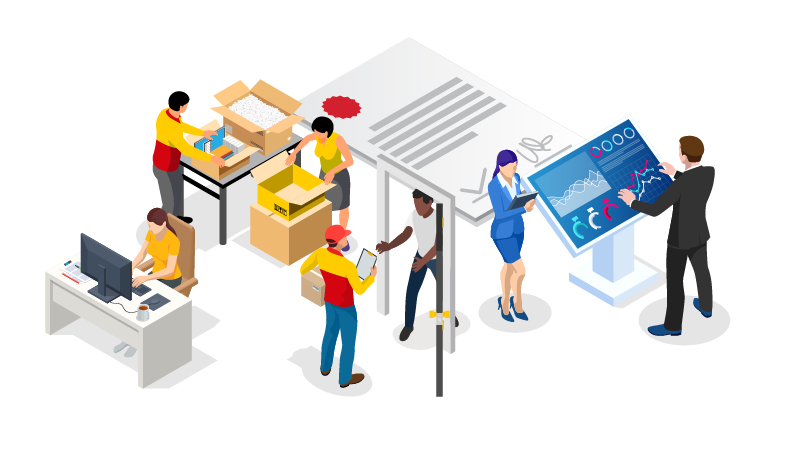
D - F
Under this international trade term, the seller is responsible for arranging transportation and delivery of the goods, ready for unloading, to a specific destination agreed to with the buyer. Once there, responsibility for all costs and risks associated with the shipment transfer from the seller to the buyer.
Similar to Delivered at Place, but here, it is also the responsibility of the seller to unload the goods at the destination before handing over the risks and costs to the buyer. (Formerly known as “Delivered At Terminal.”)
This is when the seller takes responsibility for the transportation of the goods (including the associated fees), and paying all import taxes and duties due when the shipment crosses borders.
The seller is responsible for delivering the goods to their destination and the cost of their transportation, but the buyer must pay all associated import taxes and duties due.
The declarant – sometimes called the Importer of Record – is the party responsible for ensuring all customs compliance obligations are met on a cross-border shipment. This includes presenting the customs declaration, submitting other necessary documents and permits, and paying any relevant taxes and duties. The declarant may be a third-party submitting customs declarations on behalf of an importer or exporter.
This is a statement from an exporter about the origin of its products – including the originating status of the materials used. This indicates to customs authorities where the goods were manufactured, and thus which duties and taxes apply.
Within shipping, demmurage is a fine levied by a carrier or freight service to a buyer who does not take their goods away from a port or terminal within a pre-agreed time.
This Latin term is a shortened version of the expression “de minimis non curat lex”, meaning “the law does not care about very small matters”. It is often considered more efficient to waive very small amounts of duties and taxes rather than collect them; the legal term for this threshold is De Minimis Threshold.
A detailed description of a package, including its size and weight, value, destination, the shipper’s and receiver’s details, and handling instructions.
A shipment of a document (or several documents) such as a business contract. According to customs regulations, document shipments are not considered as items of commercial value; as a result, a Commercial Invoice is not required, and clearing customs is relatively straightforward.
A business model wherein an online merchant doesn’t keep the product it sells in inventory. Instead, it partners with a wholesale supplier and passes the shipping address to them, so they ship the product directly to the customer.
These are physical goods, software and technology which can be used for both civil and military purposes. They are subject to strict exporting regulations.
A standardized format which allows one business to electronically communicate information to another – e.g., purchase orders and invoices.
A customs entry document contains important information about an imported shipment, including its country of origin and a description of the goods. A customs broker can manage this on behalf of a shipper.
A freight embargo is when a carrier stops accepting loads from shippers. The embargo may be set by local governments or by the carrier itself in the event of bad weather conditions, natural disasters, or to manage capacity during peak seasons. Shippers must wait for the embargo to be lifted or find an alternative carrier.
An Economic Operators Registration and Identification number is a system of unique identification numbers used by customs authorities monitoring and tracking shipments coming into and out of the European Union. It is mandatory for all businesses wishing to trade internationally in the EU.
This incoterm places most of the responsibility on the buyer. The shipper packages the products and makes them available at a designated location – usually their own factory. The buyer is then responsible for loading them onto the onward transport, complying with export procedures, and covering all associated costs.
This is a tax applied to goods deemed to be “harmful” to consumers – e.g., alcohol and tobacco. It is normally levied at the point of manufacture, so whilst the fees are initially covered by businesses, they are then passed on to customers via the goods’ higher price point. The aim is to deter consumers from buying such products.
This can include equipment for overseas exhibitions and trade shows. Such goods may require specialist packing and shipping support from a carrier to ensure they arrive at their destination safely and on time.
This is typically the fastest delivery a carrier offers. It includes premium services like next-day delivery and same-day delivery, and is perfect for time-sensitive shipments, such as important documents (like a replacement passport) or even just a last-minute birthday present!
To send goods or services to another country for sale. As international shipping experts, DHL can help your business decide which markets to sell to. Our country guides will get you started.
This is the selling of goods and services from one country to another. In 2021, the world exported nearly US$28 trillion worth!1
This document is needed for exports from the European Union to a non-EU country. It serves as proof from a customs office that an export is admissible.
An export consignment comprises the goods that an exporter sends to a buyer/recipient on the basis of an export contract.
This is an official form submitted to customs authorities by an exporter, which details the goods being exported – such as the value and nature of the cargo. Customs authorities use this information to control exports and compile statistics about their country’s trade.
This is a government-issued legal document that authorizes businesses or individuals to ship restricted goods abroad.
This ocean/waterway incoterm dictates that the seller is responsible for clearing goods for export and then placing them alongside the vessel at a designated port. The buyer is thereafter responsible for any costs (such as transportation to final destination), and risks of loss or damage to the goods.
Within e-commerce, first-mile delivery is the movement of goods from a merchant’s or retailer’s warehouse to their next destination. This could be, for example, the courier’s hub, where the goods are sorted ready for delivery to customers.
This is a standardized rate of e-commerce shipping where the price is determined by the size of the box or envelope, rather than the dimensional weight of the product(s) being shipped. For online sellers, it has the benefit of offering consistent shipping costs.
This sea freight shipment term determines at what point the seller passes liability for all costs, obligations and risks associated with the goods being transported to the buyer.
A fourth-party logistics provider will manage all aspects of the supply chain for a business.
For example, DHL’s role as a 4PL provider for an e-commerce business would cover transportation, warehouse operations, packaging, and final-mile delivery. DHL will also manage 3PL service providers (such as a factory), so that the client has just one point of contact. Discover more – including the next-generation 5PL – here.
This trade term signifies that the seller must arrange transportation and delivery of the goods to a named destination chosen by the buyer (hence the “free” refers to the buyer’s lack of obligation to manage the goods at this step.) The seller is also responsible for export clearance. The buyer may choose for the goods to be delivered to their forwarder’s warehouse, for example. Once they have been delivered, the buyer is responsible for unloading, paying for post-carriage shipping, and covering insurance.
This is a designated area within a country that is considered to be outside its customs territory. As a result, importers can bring foreign goods there without paying customs duties and taxes. Also called “free ports” and “free trade zones”, examples include seaports, airports and warehouses.
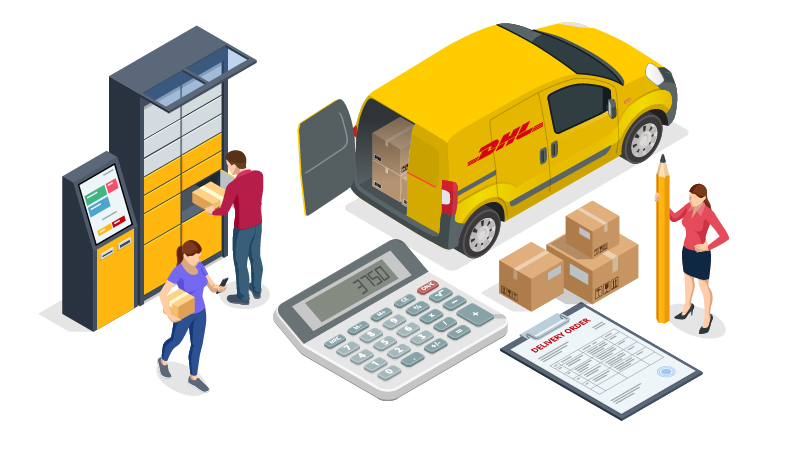
G - L
This is required on a shipment’s Commercial Invoice and Air Waybill to help customs authorities calculate relevant taxes and duties. It should be clear, detailed and accurate to ensure the goods are kept moving. For example, “apparel” would be considered too vague, but “men’s jackets” would be acceptable.
Within logistics, handling costs are incurred when goods are prepared for shipping. They are typically those you’d associate with warehouse operations, such as packaging, labeling and loading.
This is an internationally recognized system to unify the classification of traded products. The shipper is responsible for providing an HS code for their shipment. Here’s everything you need to know, in a simple but detailed guide.
This is the total quantity of goods that a recipient receives from a consignor (exporter).
This is a tax levied on imported goods by a country’s customs authorities. The amount is typically determined by the goods’ value and differs for every country. The aim is to increase the goods’ price for end customers and thus encourage them to buy from the domestic market instead.
Each country will have its own list of restricted items to regulate the goods crossing its borders. Those wishing to import such items will need official permission from the government in the form of an import license.
VAT stands for value-added tax and is collected on goods imported into a country. Each territory will have its own rules to determine how it is calculated. In the UK, for example, businesses importing goods from the EU will be required to pay 20% VAT on the products purchased. (There are some exceptions for certain goods, though.)
This is the process of directly reducing or removing carbon emissions from a company’s supply chain or operations (rather than offsetting emissions through external projects.) Examples include DHL’s GoGreen Plus solution which enables customers to reduce the carbon emissions associated with their shipments by up to 80% through the use of Sustainable Aviation Fuel.
This is the movement of freight by two or more modes of transportation. This could mean a combination of truck, rail and ship, with different carriers (and contracts) for each step of the journey.
These are all the costs associated with the management of inventory, including the initial cost of the goods, storage, equipment and insurance. It also covers the money that is tied up in the stock (i.e., cash flow cycles.)
Within logistics, when goods are sold or shipped, an invoice is generated to trigger the payment process. An example is a freight carrier issuing an invoice to a shipper after their cargo has been delivered. An invoice typically includes the date by which the payment must be made.
Put simply, this is the total cost of getting a product from the factory to a customer’s door. It includes shipping fees, insurance, and any customs and duties due when the goods cross borders. Knowing their landed costs help businesses price their products correctly. Here’s how to calculate yours.
Logistics refers to the planning framework that enables businesses to store and transport their goods to their customers. It covers procurement, inventory management, distribution, warehousing, transportation, packaging and risk management.
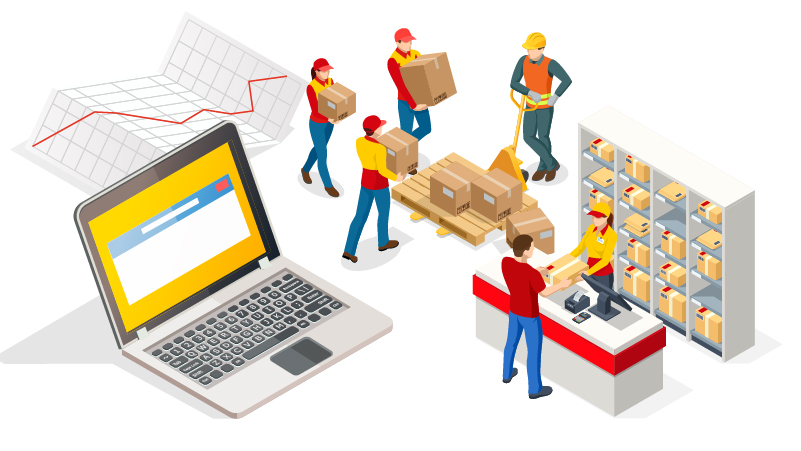
M - P
This document allows shippers to claim a preferential rate of duty when moving certain goods between countries that have bilateral trade agreements.
This is the movement of freight by two or more modes of transportation (truck, rail, ship etc.), but under a single contract. The carrier is liable for the entire carriage.
A shipment that contains items other than documents e.g., electronics, clothing, cosmetics. Such goods typically require a Commercial Invoice.
Goods entering the European Union (EU) territory are given a customs status of Union Goods or Non-Union Goods. Only the former are considered to be in free circulation and thus are not subject to customs supervision.
This flexible delivery service has customers’ convenience at its center, allowing them to choose exactly when and where their orders are delivered. For example, a customer may choose to have their package left with a neighbor if they know they aren’t going to be in. Simply put, it’s a must for any e-commerce business that wishes to deliver an exceptional customer experience! Here’s where to begin.
This is when delivery of an order is made in multiple shipments. Reasons for this method may include some parts being unavailable, or stored in different warehouses.
This refers to cross-border business transactions conducted electronically. The exchange of data and documents in this way is more efficient and accurate than paper-based communications.
This is a charge by a manufacturer or distributor for processing and drop-shipping an order directly to a customer on a retailer's behalf.
In the US, there are several agencies under the federal government that regulate the import of certain goods. Cross-border shippers should adhere to the relevant agency’s regulations to ensure their goods pass through customs.
This is a point at which people or goods enter a country – such as an airport or harbour. Customs officials are often stationed at these places to regulate imports.
This is a lower duty rate applied to some imported goods from certain specified countries. It is based on the value of goods and the country of origin. To claim this rate, shippers typically need to submit some kind of Proof of Origin.
This invoice is provided by a supplier before shipping, specifying the terms of the sale, the goods to be sent, their value, and specifications. It is essentially a quote, so is not legally binding.
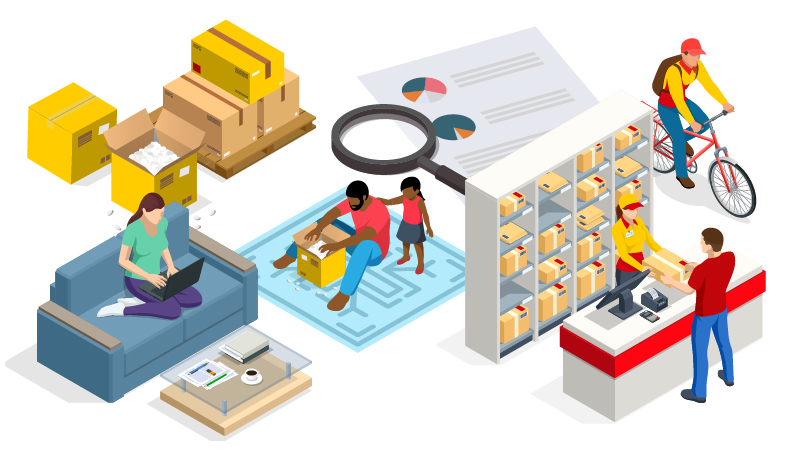
R - Z
Merchandise returned to a seller by a buyer. E-commerce customers might return goods to a retailer because they are faulty, damaged or not as described. Some online retailers offer customers free returns to incentivize them to buy – such things will be laid out in the retailer’s returns policy.
Reverse logistics is the movement of goods “upstream” through a supply chain, to return them from the end customer back to a retailer or manufacturer. The model encourages sustainable actions to divert the goods from landfill/disposal, including recycling, repurposing, repairing and resale.
Within shipping, this is the process of checking all aspects of a trade transaction against regulations, sanctions and enforcement actions. It is designed to ensure the goods and parties involved are not connected to criminal activities, like money laundering or terrorism.
This is the commercial value of the goods within a single shipment – i.e., the total amount invoiced to the buyer for the product. It is a required entry on an international shipment’s Commercial Invoice to help customs authorities calculate the taxes and duties due.
The costs incurred when inventory is stored in a warehouse or similar facility. Fees are often calculated based on the storage time and amount of space needed.
An additional charge added to a cost. Within logistics, for example, a surcharge may be added to a shipping cost by the carrier due to additional handling expenses.
An internationally recognized numerical system created by the World Customs Organization. Every product involved in global commerce is assigned a number to determine its goods category and thus what customs duties and VAT are payable.
A tiered system that permits a lower duty rate for certain quantities of imported commodities. Quantities exceeding the quota will incur higher rates.
Within international trade, taxes are charged on imported and exported goods by customs authorities in the form of duties and tariffs. These are typically determined by the goods’ value, and the country’s own rules. Any business shipping internationally will need to factor in these costs into their pricing strategies.
A third-party logistics provider will manage the logistics for a business, including the warehousing, packing and shipping of the goods. The provider may be asset based, or leverage established partnerships with other suppliers – e.g., a courier company – to secure services for its client at the best price.
Goods entering the European Union (EU) territory are given a customs status of Union Goods or Non-Union Goods. Only the former are considered to be in free circulation and thus are not subject to customs supervision.
This is an essential piece of documentation for international shipments. It is usually attached to the exterior of the shipment so anyone handling it can easily access important information, including the shipper’s and receiver’s details, a description of the contents, and who is responsible for paying associated duties and taxes.
The Waybill contains shipping ID too, so the shipment can be tracked in real time.





